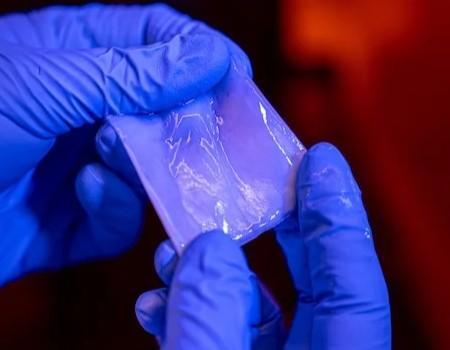
Supermaterial that outperforms metals and glass created
Imagine a material that is as strong as some metals and glasses, but also transparent, foldable, and eco-friendly. Sounds like a dream come true, right? Well, scientists at Rice University and the University of Houston have made this dream a reality by creating a supermaterial that outperforms its traditional counterparts.
The supermaterial, made by guiding bacteria to grow cellulose in aligned patterns, has the potential to revolutionize various industries, from packaging to electronics. The biopolymer sheets are not only strong but also transparent, making them ideal for use in display screens and other applications where transparency is crucial.
The research, led by Dr. Jun Song, a professor of chemistry at Rice University, and Dr. Jeffrey S. Young, a professor of chemical and biomolecular engineering at the University of Houston, was published in the journal Science Advances.
According to the researchers, the biopolymer sheets are capable of carrying heat, integrating advanced nanomaterials, and transforming packaging. They can also be customized to have specific properties, such as flexibility or conductivity, making them highly versatile.
The creation of this supermaterial is a significant breakthrough in the field of biomaterials, which involves the use of biological molecules, such as proteins and polymers, to create new materials. The researchers achieved this by using a type of bacteria called Gluconacetobacter xylinus, which is known for its ability to produce cellulose.
The bacteria were grown in a medium that contained a nutrient-rich solution and a polymerase enzyme, which helped to align the cellulose fibers in the desired pattern. The resulting biopolymer sheets were then harvested and processed to create the final material.
One of the most significant advantages of this supermaterial is its eco-friendliness. Unlike traditional materials, such as plastics and metals, which are often produced using non-renewable resources and contribute to waste and pollution, the biopolymer sheets are biodegradable and can be composted.
“This is a game-changer for the materials science community,” said Dr. Song. “We’ve created a material that is not only strong and transparent but also eco-friendly and sustainable. This opens up a lot of possibilities for applications in packaging, electronics, and other fields.”
The researchers are already exploring potential applications for the supermaterial. For example, they are investigating its use in packaging, where it could replace traditional plastics and help reduce waste and pollution. They are also exploring its potential use in electronics, where it could be used to create flexible and transparent displays.
In addition to its potential applications, the creation of this supermaterial has also shed light on the potential of biomaterials to transform various industries. By using biological molecules to create new materials, scientists can create materials that are sustainable, eco-friendly, and highly versatile.
“This is a great example of how biomaterials can be used to create new materials that are not only sustainable but also have unique properties,” said Dr. Young. “We’re excited to see where this research will take us and how it will impact various industries.”
In conclusion, the creation of this supermaterial is a significant breakthrough in the field of biomaterials. With its strength, transparency, and eco-friendliness, it has the potential to revolutionize various industries and transform the way we produce and use materials.
Source: https://news.rice.edu/news/2025/rice-researchers-develop-superstrong-eco-friendly-materials-bacteria






